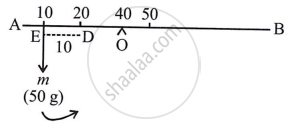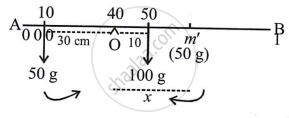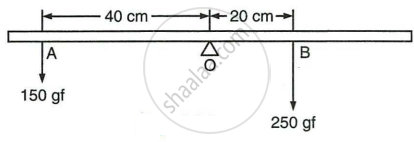Advertisements
Advertisements
Question
A uniform metre rule of mass 100 g is balanced on the fulcrum at mark 40 cm by suspending an unknown mass m at the mark 20 cm.
- Find the value of m.
- To which side the rule will tilt if the mass m is moved to the mark 10 cm?
- What is the resultant moment now?
- How can it be balanced by another mass of 50 g?
Solution
i. The 100 g weight of the rule produces a clockwise motion around the knife edge. Using the principle of moments, O. Wt. mg generates an anticlockwise moment.
Anticlockwise moment = Clockwise moment
(40 − 20) × M g = 100 g (50 − 40)
20 M g = 100 × 10

M = `(100 xx 10)/20`
= 50 g
ii. Suppose mass M is shifted to the left, or to the 10 cm mark. The rule will tilt to the left, or M's side.
iii. When M (50 g) is moved to left from 20 cm mark to E 10 cm mark by 10 cm.
Resultant moment now = M g × 10 cm
= (50 × 10) gf × cm

= 500 gf × cm anticlockwise
iv.

Let a mass of 50 g be suspended at a distance of x cm from O to the right side to balance the mass of 50 g at the 10 cm mark.
∴ Clockwise moments = Anticlockwise moment
100 × (50 − 40) + (50 × x) = 50 (40 − 10)
100 × 10 + 50x = 50 × 30
1000 + 50x = 1500
50x = 1500 − 1000
50x = 500
x = `500/50 = 10` cm to the right from the 40 cm mark, i.e., at 50 cm mark.
APPEARS IN
RELATED QUESTIONS
Describe a simple experiment to verify the principle of moments, if you are supplied with a metre rule, a fulcrum and two springs with slotted weights.
A uniform metre rule is pivoted at its mid-point. A weight of 50 gf is suspended at one end of it. Where should a weight of 100 gf be suspended to keep the rule horizontal?
When a boy weighing 20 kgf sits at one end of a 4 m long see-saw, it gets depressed at this end. How can it be brought to the horizontal position by a man weighing 40 kgf.
A physical balance has its arms of length 60 cm and 40 cm. What weight kept on pan of the longer arm will balance an object of weight 100 gf kept on other pan?
A uniform metre rule balances horizontally on a knife edge placed at the 58 cm mark when a weight of 20 gf is suspended from one end.
- Draw a diagram of the arrangement.
- What is the weight of the rule?
The diagram in Fig. shows a uniform metre rule weighing 100 gf, pivoted at its centre O. Two weights 150 gf and 250 gf hang from the point A and B respectively of the metre rule such that OA = 40 cm and OB = 20 cm. Calculate :
- the total anticlockwise moment about O,
- the total clockwise moment about O,
- the difference of anticlockwise and clockwise moments, and
- the distance from O where a 100 gf weight should be placed to balance the metre rule.

A uniform metre rule of weight 10 gf is pivoted at its 0 mark.
- What moment of force depresses the rule?
- How can it be made horizontal by applying a least force?
A uniform half-metre rule can be balanced at the 29.0 cm mark when a mass of 20 g is hung from its one end.
- Draw a diagram of the arrangement.
- Find the mass of the half-metre rule.
- In which direction would the balancing point shift if 20 g mass is shifted inside from its one end?
A uniform metre rule of mass 100g is balanced on a fulcrum at mark 40cm by suspending an unknown mass m at the mark 20cm.
How can it be balanced by another mass 50 g ?
State the principle of moments.
